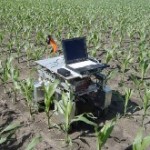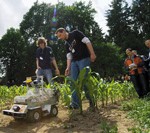 Robots specialized in agriculture have been developed by engineers at the University of Illinois in order to automate the heavy labor of farmers. These robots can detect diseased plants, alert other robots of the existence of a pest and get everyone together to fight as a team with the help of satellites. New generations of these robots able to plant and spray. All these technologies will lead to the farm of the future, comparable to houses equipped with all modern technologies, integrated into a single system that regulates everything. After redeeming the services and industrial sector, it seems that robotics finally decides to drive the primary, fundamental for developing countries. By Eduardo Martinez Scientific Trends.
Robots specialized in agriculture have been developed by engineers at the University of Illinois in order to automate the heavy labor of farmers. These robots can detect diseased plants, alert other robots of the existence of a pest and get everyone together to fight as a team with the help of satellites. New generations of these robots able to plant and spray. All these technologies will lead to the farm of the future, comparable to houses equipped with all modern technologies, integrated into a single system that regulates everything. After redeeming the services and industrial sector, it seems that robotics finally decides to drive the primary, fundamental for developing countries. By Eduardo Martinez Scientific Trends.
Ingenieros agronomists at the University of Illinois have developed a range of small robots flights (between 150 and $ 500 each) specially designed for agricultural work and replace the bulky and expensive machines that are currently used for planting, spraying, harvesting and plowing.
Today, these little robots only perform tasks of retrieval and transmission of information on the ground in a completely new in the agricultural sector: distributed by acres of land, are able to direct their inquiries, to exchange information with other units and detect epidemics and dangerous insects, warning it to the other robots deployed in the field.
One of these robots looks like something out of the movie “Star Wars” as the R2D2, while others are like little ants than 30 centimeters long, which have the ability to function as an ecosystem, ie, communicate with each other and, as bees do, help each other if necessary.
The main advantage of this generation of robots is that they are small, lightweight and autonomous. The weight is very important because the move does not alter the conditions of the land, contrary to what happens with the current agricultural machines, large and heavy, which affects the environment.
The characteristics of these robots able to collect local information on each plant a crop, which is a huge advantage over traditional monitoring systems, which obtain global information but not close to reality, which in many sometimes prevents early detection problems in crops.
These small robots, in contrast, can detect and transmit real-time complete information of the status of a crop that includes the presence of diseases, weeds, harmful insects and other agricultural incidents. The information may be shared with other robots and robot joint action trigger.
Agricultural robotics, new science
As explained by one of the architects of agricultural robots, E. Tony Grift, in an article published in Agricultural and Biological Engineering, Agricultural robotics logic is the proliferation of automation technology applied to bios stems such as agriculture, forestry, fisheries and related industries.
At the moment it is only prototype agricultural robots, so its presence in the market will take another few years, according to its creators, who seek to create an experimental farm where all work would make these robots. To achieve this, the next generations of these robots will cover all the tasks of the field, creating a new business model called “farm of the future.”
This first generation is equipped with a camera that detects the weeds, but later these cameras also find plant diseases. The marking of insects and parasites is still only at the project level.
Second generation
The second generation of agricultural robots intended to go further and more complex undertaking agricultural tasks, such as mechanical failure and fumigated ground with the help of GPS, satellite guidance system.
This second generation of robots will also be small, except it is engaged in harvesting, which must be of a size equivalent to that of existing machines, driven directly by man.
The third generation will be part of a larger system to manage a whole farm of the future, with complementary activities to the strictly agricultural, and livestock and business management.
The result of these three stages of penetration of modern technologies in the field is what the architects of this invention called the farm of the future, comparable to houses imagined with all the modern technologies integrated into a single system that regulates everything.
The farm of the future will be managed in its entirety by a computer system that regulates the activity of the robots that take the field with the help of satellites, while aware of the situation of the markets they are targeted crop products and directs the milking of cows, which is done by robots (robots already operating in some countries with proven effectiveness).
The original size is
The idea of applying robots to agriculture is not new, but what is original by the engineers of Illinois is the size of these automata. On the other hand, in Japan and there are some small autonomous robots to adapt to difficult plant rice paddy field.
Similarly, and also within the primary sector, there are robotic experience in aquaculture. The University of New Hampshire United States, for example, develops a proposed offshore aquaculture. In addition, other programs such as the Pacific Ocean Salmon Tracking Project, designed to follow schools of fish with the help of satellites.
In Spain, the National Research Council is also developing research related to autonomous navigation of robots in agriculture.
This shows that the most advanced technologies increasingly penetrate deep into the primary sector, which is almost residual in developed economies but of great importance to developing countries. Robotics, after redeeming the services and industrial sector, it seems that finally decides to drive the primary.







